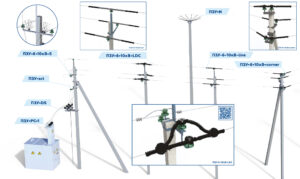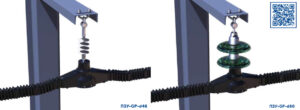Third International Scientific and Practical Conference “Eagles of the Palearctic: Study and Conservation”
Raptors Conservation. Suppl. 2. Proceedings of Conferences
Bird protection devices for overhead power lines and electrical substations – problems of monitoring and evaluating the effectiveness of bird protection measures
Tsittser V.V., Andreev O.B. (Avis LLC, Tolyatti, Russia)
Contact:
Vladimir Tsittser Oleg Andreev avisplast@mail.ru
Recommended citation: Tsittser V.V., Andreev O.B. Bird protection devices for overhead power lines and electrical substations – problems of monitoring and evaluating the effectiveness of bird protection measures. – Raptors Conservation. 2023. S2: 413–418. DOI: 10.19074/1814-8654-2023-2-413-418 URL: http://rrrcn.ru/en/archives/35181
Experts point out that “A quarter of all overhead power lines outages are caused by birds, and 86% of grid companies name birds as main problem”.
Unfortunately, this is the key factor in the problem of mass death of birds: power engineers are forced to protect lines from birds, while the issue of protecting birds from lines has lower priority.
In any case, it all comes down to one question: what should we do?
Solution 1: cable lines.
Pros:
+ Absolutely safe for birds.
Cons:
- Not possible to apply to currently existing lines, only new construction is possible,
- High costs of underground works,
- Inapplicability of underground cables in some areas.
Solution 2: retrofitting with self-supporting insulated wire (SIW).
Pros:
+ Mostly safe for birds.
Cons:
- Remaining of potentially danger zones for birds (wire punctures, linear disconnectors),
- High costs compared with bare wire,
- Inapplicability of SIW in some areas (for example, in high temperature regions only bare wire can be used).
Solution 3: bird protection devices (BPDs).
Pros:
+ Different types of BPDs for different categories of tasks,
+ Low cost of devices,
+ Could be applied to any existing line in short terms.
Cons:
- Distrust towards new types of devices, preference to work "the old-fashioned way",
- Numerous attempts by power line owners to ignore the advantages of devices for the sake of economy.
Now let's talk about bird protection devices (BPDs).
The idea of BPD is very simple. So simple that many companies produce by themselves different perching and antiperching modifications.
Unfortunately, those solutions may be not only unhelpful, but also harmful.
To avoid such cases, BPDs are now undergoing rigorous testing to meet the highest international technical standards (GOST), which apply to all elements of power lines.
An important part of testing is pilot operation when our BPDs are used in real conditions by grid companies.
It is important to note that pilot operation is mainly run without control by ornithological organizations. This initiative comes from BPD-developers, who wanting to provide devices for testing, and grid companies wanting to test BPDs at their most problematic facilities.
For completeness of testing, we also run full-scale tests on birds in special zoos under complete bird safety to make sure that BPDs performs well in real conditions and its design is safe for birds.
Due to the lack of officially approved assessment methods, manufacturers rely on the recommendations of biologists from specialized institutes.
Conclusions about the effectiveness of BPDs are made on the basis of indirect signs of the vital activity of birds.
BPDs manufactured by a certified manufacturer meet all standards, their tests are confirmed by certificates, they have reviews and recommendations.
Our company is investigating the problem, while non-certified manufacturers simply sell outwardly similar solutions.
Shortly about the “Avis” company production.
We have several types of BPDs for different tasks:
- Anti-perching group of devices (perching deterrent) prevent birds from perching in danger zone. This group is represented by the models “BPD-lid” for large bird species, “BPD-S” for all-scale bird species and “BPD-SL” to protect the inner parts of the pylons from nest-building.
- Isolating group of devices should ensure safety for a perching bird. It is represented by “BPD-line” model for pin insulators and “BPD-gp” model for suspended insulators.
- To provide safety at linear disconnectors we offer “BPD-DS” model – a device of isolating type that fully cover currentcarrying parts and a “BPD-FB” model – combined type device that does not allow to circuit adjacent phases.
- A special category of our production is artificial nests for large bird species. It is better to install the artificial nest on a new pole without wires, but also possible to use specially designed outriggers to mount the nest on a pole in lines that are already in operation.
We also want to highlight that many countries have no regulatory frameworks and laws for the protection of birds from electrocution.
How to evaluate the effectiveness of bird protection?
There are 2 main approaches:
1) To gather statistics from grid companies on the problem sections of power line – to retrofit them with BPDs – to evaluate the effect after a certain period.
2) To initiate a field examination of a stretch of power lines – to retrofit it with BPDs – to evaluate the effect after a certain period.
But here we are faced with some problems in evaluating the effectiveness of devices. First of all, methods and criteria of evaluation BPD’s effectiveness are not defined or documented either globally or locally. This kind of research is usually carried out by public organizations, while governmental institutions are less involved in the process.
As a result, the outcomes of these studies rarely become a priority. Conducting a qualitative study takes several years since power line examination and dead bird counting should be done year after year before and after power line retrofitting with BPDs to track the dynamics and draw an unambiguous conclusion about the applicability of the selected types of BPDs in a chosen region or the need to replace them.
In most known cases, there is no collaboration between grid companies and environmental/ornithological organizations in carrying out research or in maintaining power lines.
Also, grid and engineering companies do not have maps of migration corridors, so they may completely overlook this factor in their work.
When BPD is installed at one of the sites, the dynamic equilibrium of the ecosystem in the analyzed region is changed.
In the example with artificial nests, we recommend mounting them on a pole standing separately from the main line, while hazardous parts of the line should be retrofitted with anti-perching models of BPDs. Only complex approach can achieve excellent results.
As a conclusion: we have no influence on the duration of the study of the effectiveness of bird protection measures, but if we join forces of BPD developers, environmentalists, engineers, grid companies and governmental organizations, it will become possible to protect both birds from power lines and power lines from birds.


